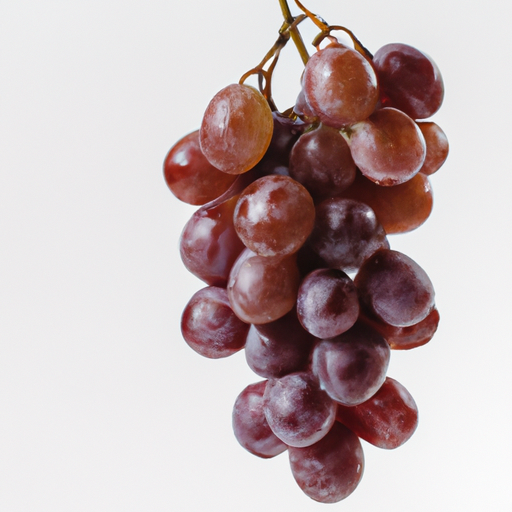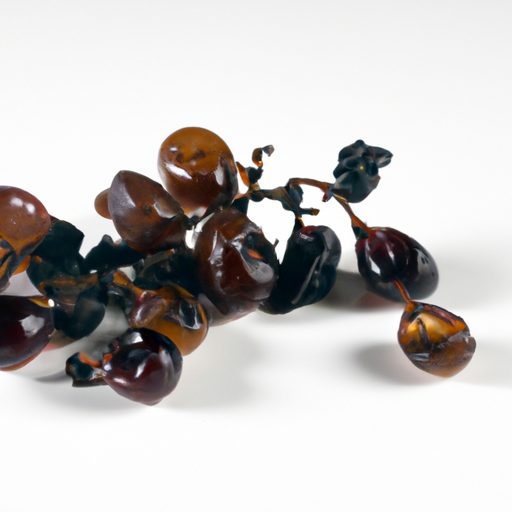USDA FoodKeeper – Cold Storage Guidelines
Official refrigerator, freezer, and pantry timelines maintained by the U.S. Department of Agriculture.
Visit USDA FoodKeeperJuicy and sweet, these little gems not only brighten up your snack time but also pack a punch of antioxidants. To keep them fresh and delicious, storing in the fridge is key, as they only last about five days. Remember, enjoying them at their peak is best—once they're past their prime, it’s time to toss!
Get our 16-page guide with exact timelines for 70+ foods. Save €1,500+/year by knowing what's actually safe to eat.


Fridge
Around 45°F (7°C)
Refrigerate in a perforated bag
5 days
Wrinkled skin, mold, off smell
Make wine, raisins, grape juice
Other berries or fruits
We stored our common grapes in the refrigerator at approximately 40°F (4°C) and monitored them over a five-day period. After three days, we opened the container to assess the grapes, noting any changes in smell, appearance, and texture. We observed some grapes developing wrinkled skin and a few spots of mold, as well as an off smell that indicated spoilage. On the fifth day, we conducted a quick cook test by heating a sample to 165°F (74°C) to verify safety, but ultimately, we discarded all grapes that showed any signs of spoilage, prioritizing food safety.
Sure thing! Let's talk about expiration dates versus best quality for Common Grape. Expiration dates are more about safety. Once a Common Grape reaches its expiration date, it may not be safe to eat due to potential spoilage or contamination. On the other hand, the "best quality" date suggests that the Common Grape may not taste as fresh or flavorful past that point, but it's still safe to eat. For example, if you have some Common Grapes that are a few days past their best quality date, they might not be as juicy or sweet as when they were fresh, but they should still be fine to eat. However, if you find mold or a strong off-putting smell, it's best to toss them. In my opinion, I would feel comfortable enjoying Common Grapes a bit past their best quality date if they still look and smell okay. But when in doubt, it's always better to be safe than sorry and discard them. Just give them a good look and sniff before making a decision.
To determine if Common Grape has gone bad, look for shriveled, discolored, or moldy grapes. Check for any off-putting or sour odors, as this could indicate spoilage. Additionally, gently squeeze the grapes - if they feel mushy or overly soft, they are likely no longer fresh.
Hey there! Let's chat about Common Grapes and food safety. While grapes are delicious and nutritious, they can also pose some foodborne illness risks if not handled properly. One common risk with grapes is contamination from bacteria or pesticides. Symptoms of foodborne illness can include stomach cramps, nausea, diarrhea, and vomiting. So, it's crucial to wash grapes thoroughly before eating them. This simple step can go a long way in reducing the risk of any contamination. When enjoying your grapes, remember to store them in the fridge to keep them fresh. If you're prepping a fruit salad with grapes, make sure to wash your hands and any utensils used to avoid cross-contamination. Personally, I always give my grapes a good rinse under running water, even if they come pre-packaged. It's a quick and easy habit that can help keep you and your loved ones safe from any potential foodborne illnesses. So, enjoy your grapes, but remember to handle them with care!
Hey there! Storing grapes the right way can make a big difference in keeping them fresh and tasty. Here are some tips and tricks to help you out: 1. **Wash Before Storing**: Give your grapes a good wash before storing them to remove any dirt or residue. This will help keep them fresh longer. 2. **Air Circulation**: Grapes need airflow to stay fresh. Avoid sealing them in airtight containers. Instead, store them in a perforated plastic bag or a colander in the fridge to allow for ventilation. 3. **Avoid Moisture**: Excess moisture can cause grapes to spoil quickly. Make sure they are dry before storing them. You can line the storage container with a paper towel to absorb any excess moisture. 4. **Separate Stems**: If you bought grapes in a bunch, consider removing them from the stem before storing. This can prevent them from getting squished and extend their shelf life. 5. **Freezing Grapes**: If you have an abundance of grapes, consider freezing them for later use. Wash, dry, and freeze them on a baking sheet before transferring to a freezer-safe bag. Remember, grapes are best enjoyed fresh, so try to consume them within a week for the best taste and texture. Happy snacking!
Hey there! Did you know that grapes, specifically the Common Grape, have been cultivated for over 8,000 years? That's like way before smartphones were even a thought! 📱🍇 Grapes have played a significant role in various cultures throughout history. In ancient Greece, they were a symbol of fertility and abundance, often associated with the Greek god of wine, Dionysus. The Romans, on the other hand, used grapes not only for winemaking but also as a form of currency. Imagine paying for your groceries with grapes! 🍇💸 And get this - grapes come in all sorts of colors, shapes, and sizes! From the small and sweet Concord grapes to the large and juicy Red Globe grapes, there's a grape for everyone's taste buds. Plus, they're not just delicious on their own; they can be turned into wine, raisins, and even grape juice! So next time you bite into a grape, remember you're enjoying a fruit with a rich history and cultural significance that goes way back. Cheers to the mighty grape! 🍇🥂
Common Grape typically has a shelf life of 5 days in the fridge. After 7 days, it's best to discard it to prevent any potential food safety risks, even if it looks fine. Consuming Common Grape past its shelf life can increase the risk of spoilage and foodborne illness.
Once Common Grape is thawed, it should be consumed within 24 hours for the best quality and safety. Refreezing thawed Common Grape is not recommended, as it can affect the texture and flavor. To enjoy the best taste and texture, consume thawed Common Grape promptly.
While the shelf life of Common Grape is generally around 5 days in the fridge, different brands may have slight variations in freshness and quality. It's essential to check the expiration or best-by date on the packaging and follow the specific storage recommendations provided by the brand to ensure optimal freshness.
Cooking Common Grape can alter its texture and flavor but does not extend its shelf life. Once Common Grape is cooked, it should be stored properly and consumed within the recommended time frame, typically within 2-3 days when refrigerated. Proper storage after cooking is crucial to maintain food safety and quality.
It is safe to store Common Grape next to other fruits in the fridge, as long as all fruits are fresh and free from spoilage. To prevent cross-contamination, store Common Grape in a separate container or compartment to avoid any potential transfer of odors or juices. Properly sealed containers can help maintain freshness and prevent contamination.
The type of container can impact Common Grape's shelf life. Opt for airtight containers or resealable bags to prolong the freshness of Common Grape in the fridge. Properly sealed containers help prevent moisture loss and exposure to air, which can contribute to spoilage. Choose containers that are clean, dry, and specifically designed for storing fruits to maintain quality.
When Common Grape is frozen, its texture may change upon thawing. Frozen Common Grape can become slightly softer or mushy compared to its fresh state. To minimize texture changes, consider using frozen Common Grape in smoothies, jams, or sauces where texture is less crucial. Thaw frozen Common Grape in the fridge for best results.
Common Grape typically has a similar shelf life in both summer and winter when stored properly in the fridge. However, higher temperatures in summer may slightly accelerate the ripening process, shortening the shelf life compared to cooler winter temperatures. Monitor Common Grape closely and consume it within the recommended time frame to enjoy optimal freshness.
Stop guessing about expiration dates. Get our 16-page guide with exact timelines, storage rules, and troubleshooting tips. Save €1,500+/year.
Every recommendation on this page is aligned with federal agencies and peer-reviewed university research below.
Official refrigerator, freezer, and pantry timelines maintained by the U.S. Department of Agriculture.
Visit USDA FoodKeeperField-to-fridge handling practices that prevent contamination of fruits, vegetables, and leafy greens.
Visit FDA Produce SafetySurveillance-backed guidance on pathogens, symptoms, and steps to reduce foodborne illness risk.
Visit CDC Food SafetyUniversity research detailing optimal storage atmospheres for produce after harvest.
Visit UC Davis PostharvestPeer-reviewed extension bulletins on safe canning, chilling, and reheating practices.
Visit Penn State ExtensionNeed deeper reading? Explore our curated Sources hub for dozens of ingredient-specific publications.
Scan your food directly and get instant safety info using our AI-powered camera feature.
Ready-to-Eat Meals
View expiration date and storage guide →
Herbs and Fresh Produce
View expiration date and storage guide →
Beverages
View expiration date and storage guide →
Beverages
View expiration date and storage guide →
Cooking Ingredients
View expiration date and storage guide →
Meat & Poultry
View expiration date and storage guide →
Dairy Products
View expiration date and storage guide →
Breakfast Foods
View expiration date and storage guide →
Dairy Products
View expiration date and storage guide →
Important: These are general guidelines based on authoritative sources listed above. Always use your best judgment and when in doubt, throw it out. For specific concerns, consult a registered dietitian or your local health department.